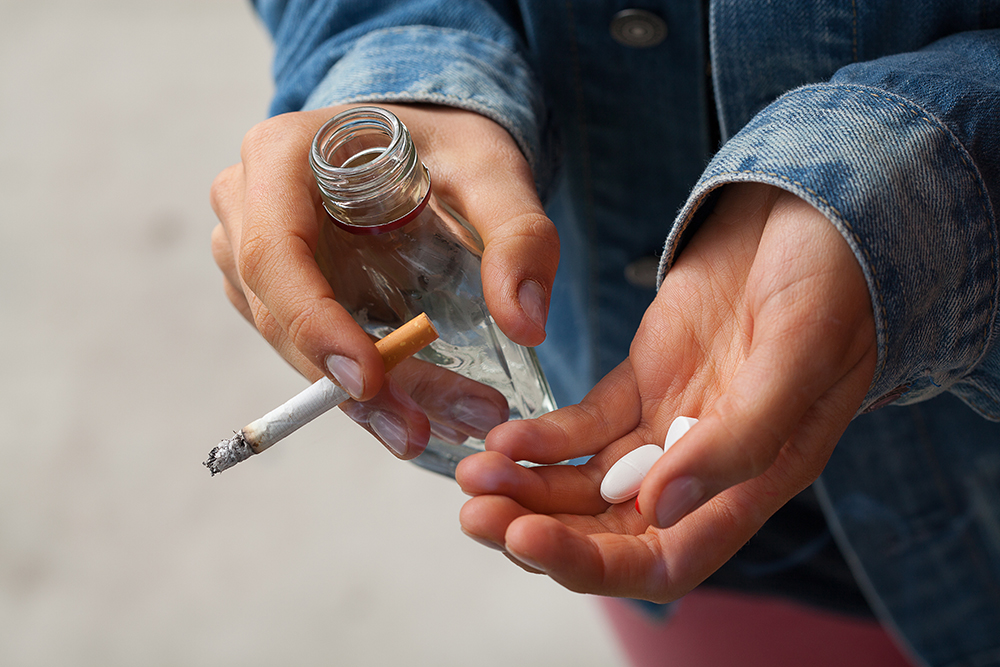By Daniel Butcher
Contrary to popular belief, university students don’t get drinking out of their systems during their college years before entering the workforce. Studies show drinking levels increase after graduation and peak in the mid-20s.
Academy of Management Scholar Peter Bamberger of Tel Aviv University said that especially for some client-facing roles such as sales, on-the-job pressures and social situations often lead to increased alcohol consumption among young professionals.
“The common perception is that people’s drinking is at its highest levels for young adults, at least when they’re in college, and then as soon as they get out of college, they take on employment; they start their career, and their drinking very quickly declines,” Bamberger said. “However, there’s been some indication already for the past 10 years that that may not be the case.
“In fact, the data on young adults shows that, particularly among college students and twenty-somethings, the peak levels of alcohol use and misuse are actually at around ages 25 and 26, and they’re continuously rising after graduation,” he said. “It’s not like people graduate from college and mature out of their drinking—the party continues.”
Bamberger and colleagues have studied different profiles of alcohol drinkers. Their research findings don’t always align with popular narratives about booze consumption.
“We’ve looked at how people drink alcoholic beverages, how frequently and when they drink, and there are certain patterns that are more problematic than others,” Bamberger said. “First of all, where individuals engage in heavy episodic drinking, like binge drinking, and they do it more frequently, and they do it not necessarily only on a weekend but during the week as well, that’s a very risky pattern.
“And then you have more in the middle of the range, moderate traits and patterns, and then you have patterns like only drinking socially or only on special occasions, and you have abstainers, but and most college students do drink—most are not abstainers,” he said.
“We have these three patterns among people who drink, and when we look at the likelihood of people shifting from a really risky pattern of heavy drinking to a more moderate pattern, or from a moderate pattern to light drinking, what we find is that these patterns are in fact rather sticky.”
-
Daniel Butcher is a writer and the Managing Editor of AOM Today at the Academy of Management (AOM). Previously, he was a writer and the Finance Editor for Strategic Finance magazine and Management Accounting Quarterly, a scholarly journal, at the Institute of Management Accountants (IMA). Prior to that, he worked as a writer/editor at The Financial Times, including daily FT sister publications Ignites and FundFire, Crain Communications’s InvestmentNews and Crain’s Wealth, eFinancialCareers, and Arizent’s Financial Planning, Re:Invent|Wealth, On Wall Street, Bank Investment Consultant, and Money Management Executive. He earned his bachelor’s degree from the University of Colorado Boulder and his master’s degree from New York University. You can reach him at dbutcher@aom.org or via LinkedIn.
View all posts
Up next....
Why You Should Be Kind to Medical Staff
By Daniel Butcher
While many people worldwide experience frustration with their healthcare system, taking it out on individual healthcare workers can backfire. Rudeness toward medical staff can lead to more delays and even errors.
Academy of Management Scholar Peter Bamberger of Tel Aviv University said that being rude to doctors, nurses, and other medical staff can hurt their job performance because it consumes valuable cognitive resources. In short, rudeness creates a huge mental distraction.
“Our theory was that when you experience rudeness, you’re distracted because of it, and you’re not even aware that you’re distracted. But you are distracted, and as a result, you can’t pick up on a lot of the social signals that are being communicated by other people, and interactions with bosses, team members, and clients or patients are harmed by that,” Bamberger said. “We actually demonstrated that in a field experiment using medical simulations; we brought in doctors to a medical simulation center where they were working on mannequins.
“Simulation centers are increasingly used to train doctors; they have all the equipment there: They can intubate, they can see X-rays, they kind diagnose and treat maladies,” he said. “So we look at the way they interact with each other; how do they try and transmit information to each other? How do they share tasks?”
Bamberger and colleagues recorded the medical team processes while working at the medical simulation center.
“We look at their diagnostic performance, their treatment performance, and their general patient management in an intensive-care context,” Bamberger said. “First of all, what we find is that individuals who are experiencing rudeness have significantly poorer performance than those who don’t.
“It’s interesting that this rudeness experience at the start of the day has lingering effects throughout the day; it doesn’t just go away after an hour or two,” he said. “The poor diagnostic and treatment performance stays on throughout each of the scenarios that they have to deal with over the course of the day, even after lunch, so they just come in at eight in the morning, they finish at four in the afternoon, and this stuff—being distracted by bosses’ or patients’ rude behavior while they are unconsciously trying to assess any possible threat—goes on all through the afternoon.
“The differences in staff performance pre- and post-rudeness are clear.”
-
Daniel Butcher is a writer and the Managing Editor of AOM Today at the Academy of Management (AOM). Previously, he was a writer and the Finance Editor for Strategic Finance magazine and Management Accounting Quarterly, a scholarly journal, at the Institute of Management Accountants (IMA). Prior to that, he worked as a writer/editor at The Financial Times, including daily FT sister publications Ignites and FundFire, Crain Communications’s InvestmentNews and Crain’s Wealth, eFinancialCareers, and Arizent’s Financial Planning, Re:Invent|Wealth, On Wall Street, Bank Investment Consultant, and Money Management Executive. He earned his bachelor’s degree from the University of Colorado Boulder and his master’s degree from New York University. You can reach him at dbutcher@aom.org or via LinkedIn.
View all posts
Up next....
Mentors Influence How Much College Grads Drink
By Daniel Butcher
The quality of mentorship can be a key factor in early-career professionals surviving and thriving at an organization. And more specifically, senior executives’ alcohol use, especially while entertaining clients, has a big influence on junior employees’ drinking habits.
Academy of Management Scholar Peter Bamberger of Tel Aviv University said that for at least the three years after graduation, alcohol consumption levels typically don’t change much. But there’s a caveat.
“We do find a couple of factors that are instrumental in getting alcohol consumption to move, which gives managers some clues as to what might be done to speed up that maturing out process for junior employees and hopefully reduce the risk of managers having to deal with people with problem drinking,” Bamberger said. “This is a soft side of the socialization process when these young adults come into the organization, so some of the most instrumental factors have to do with mentoring programs, veteran employees who are there to support the newcomers.
“You have to be a little bit careful there, because we did another study in China, where we found that, for employees in sales and sales-support occupations who are social connectors, post-college alcohol consumption moves in the wrong direction,” he said. “Many young people coming into these positions within three months after graduation show patterns of hazardous drinking.
“We demonstrate that, in such cases, their ‘mentors’ are their clients who end up ‘teaching’ them how critical it is to drink in order to build trust and close the deal—now, this may be more of a sales-department client-related phenomenon, and it may be more intense in China than other parts of the world.”
In China, it’s well-known that salespeople can’t close a deal unless they show their clients a good time the night before a meeting. Such occasions often include heavy drinking. However, Bamberger notes that many companies based in many countries worldwide, including across Europe and the United States, have salespeople and clients who also have behavioral patterns like that.
“The socialization [process] is [influenced by] mentoring by certain individuals, which can be problematic,” Bamberger said. “But our study with a college students in the U.S. finds that where you have that kind of support, particularly with newcomers mentored by veterans with low or moderate levels of drinking, you can expedite the pace at which young adults mature out of this pattern of a high level of alcohol consumption.
“There are other factors and things that managers can do [to help expedite that maturation process] as well, some of them having less of an effect, including a review of alcohol-drinking policies as part of the orientation program—our findings are that that doesn’t do very much,” he said.
“Managers do need to look at what else worked to reduce problem drinking among their younger team members.”
-
Daniel Butcher is a writer and the Managing Editor of AOM Today at the Academy of Management (AOM). Previously, he was a writer and the Finance Editor for Strategic Finance magazine and Management Accounting Quarterly, a scholarly journal, at the Institute of Management Accountants (IMA). Prior to that, he worked as a writer/editor at The Financial Times, including daily FT sister publications Ignites and FundFire, Crain Communications’s InvestmentNews and Crain’s Wealth, eFinancialCareers, and Arizent’s Financial Planning, Re:Invent|Wealth, On Wall Street, Bank Investment Consultant, and Money Management Executive. He earned his bachelor’s degree from the University of Colorado Boulder and his master’s degree from New York University. You can reach him at dbutcher@aom.org or via LinkedIn.
View all posts
Up next....
Pay Transparency Boosts Performance, Retention of Top Performers
By Daniel Butcher
Pay transparency laws can motivate star employee stay with companies and boost their performance, while spurring poor-performing working to quit.
Academy of Management Scholar Peter Bamberger of Tel Aviv University has conducted extensive research on pay transparency, including experiments to study the implications of pay transparency and secrecy on turnover.
“We found that pay transparency generated higher retention for higher performers, but other studies done by economists found that transparency is associated with higher rates of turnover, in other words, lower retention—so we have a disconnect there,” Bamberger said.
“But there are some indications that the turnover was higher among low performers, whereas, among high performers, that transparency didn’t generate a higher rate of turnover; in those studies, transparency may not have generated higher retention, like we found, but most of the turnover that those researchers found in their field study was with lower performers,” he said.
In other words, it’s a win-win situation for leaders and managers: Greater compensation transparency does not tend to encourage high-performing (and presumably well-paid) employees to leave the organization, while it does give a nudge to low-performing (and presumably modestly paid) employees to seek employment elsewhere.
“When workers don’t know what their colleagues are making, natural biases cause many to underestimate what we call ‘instrumentality perceptions,’ the instrumental role of extra effort to achieve the right incentive benefits in driving returns,” Bamberger said. “Their motivation is lower when pay is secret, and the result is, over time, a lower growth curve in performance.
“The slope of improvement is flatter when workers don’t know how much money colleagues earn than it is when pay is transparent and they can see how they’re doing relative to others,” he said.
The main takeaway is that pay transparency boosts performance and retention of top performers while leading to turnover of poor and middling performers.
-
Daniel Butcher is a writer and the Managing Editor of AOM Today at the Academy of Management (AOM). Previously, he was a writer and the Finance Editor for Strategic Finance magazine and Management Accounting Quarterly, a scholarly journal, at the Institute of Management Accountants (IMA). Prior to that, he worked as a writer/editor at The Financial Times, including daily FT sister publications Ignites and FundFire, Crain Communications’s InvestmentNews and Crain’s Wealth, eFinancialCareers, and Arizent’s Financial Planning, Re:Invent|Wealth, On Wall Street, Bank Investment Consultant, and Money Management Executive. He earned his bachelor’s degree from the University of Colorado Boulder and his master’s degree from New York University. You can reach him at dbutcher@aom.org or via LinkedIn.
View all posts
Up next....
Pay Transparency May Breed Malicious Envy
By Daniel Butcher
Overall, researchers have found that pay transparency benefits organizations with fair compensation structures by incentivizing top performers to continue working hard and reducing turnover of talented contributors. But in certain situations, it can breed envy of high earners and undermine organizational culture.
Academy of Management Scholar Peter Bamberger of Tel Aviv University explained that envy can be either benign or malicious, with benign envy increasing a person’s motivation to help others, while malicious envy tends to decrease motivation. Bamberger said that in cases he studied where pay transparency bred malicious envy among colleagues, the frequency of employees helping one another decreased.
“So if I’m envious of you, and I can see that you’re having difficulties at work, will I help without you coming to me and asking for assistance? Will I come to you and say, ‘Hey, I can see you’re having some problems, here’s advice or some type of information that could help you solve some of the problems that you’re experiencing?’” Bamberger said.
“I’m less likely to do that if I’m feeling envy toward you, and I’m more likely to feel envy toward you under conditions of pay transparency,” he said.
“For people who are natural helpers, it won’t make much of a difference, but for most people, particularly among those who are more competitive or have less prosocial motivation, it can make a big difference.”
Some business leaders and managers complain that transparency is problematic, because it makes people jealous, but Bamberger and his colleagues didn’t buy that argument. Their hypothesis was that people are jealous whether pay is transparent or not, and they imagine what other people’s pay is and base their jealousy on that.
“Whether or not employees see other people’s pay, it’s still a basis for jealousy, because they believe the worst,” Bamberger said. “The difference when pay is transparent is that it’s slammed in your face, and you can’t deny it, and therefore, it’s particularly in that case where the malicious envy can be sufficiently robust to be problematic, while one of these problems was reduced unsolicited helping among coworkers.”
-
Daniel Butcher is a writer and the Managing Editor of AOM Today at the Academy of Management (AOM). Previously, he was a writer and the Finance Editor for Strategic Finance magazine and Management Accounting Quarterly, a scholarly journal, at the Institute of Management Accountants (IMA). Prior to that, he worked as a writer/editor at The Financial Times, including daily FT sister publications Ignites and FundFire, Crain Communications’s InvestmentNews and Crain’s Wealth, eFinancialCareers, and Arizent’s Financial Planning, Re:Invent|Wealth, On Wall Street, Bank Investment Consultant, and Money Management Executive. He earned his bachelor’s degree from the University of Colorado Boulder and his master’s degree from New York University. You can reach him at dbutcher@aom.org or via LinkedIn.
View all posts
Up next....
Pay Transparency Reduces Compensation Differentials
By Daniel Butcher
Pay transparency can lead to pay compression, in which employees’ compensation—regardless of whether they’re long-tenured or new, high-performing or just sliding by—tend to cluster around an average or median level for a particular role.
Academy of Management Scholar Peter Bamberger of Tel Aviv University said that people perceive their employer’s compensation structure to be unfair tend to leave the organization. In those cases, pay transparency can interfere with employee retention goals. But he’s found in his research that pay can be a moving target, where pressure to recruit can drive up new hires’ compensation, higher than longer-tenured employees serving in similar roles.
“It’s important to see what the impact of pay transparency is on individual behavior, but we also want to see what happens with turnover rates at the firm level,” Bamberger said. “The argument was based on several research papers in economics in particular with consistent findings that when pay becomes more transparent, it also becomes more compressed.
“Essentially, managers differentiate between stars and poor performers less and give everybody more or less the same or a similar raise and bonus,” he said.
While the economists didn’t really look at the mechanism as to why that is, Bamberger and his colleagues did examine that and came up with a theory to explain the trend.
“The argument is that managers are kind of lazy, and they prefer not to have to deal with an employee coming in and demanding that they deserve more than someone else,” Bamberger said. “So when pay is transparent, regardless of differences in individual contribution, they just give everyone the same level of pay increase or bonus.”
-
Daniel Butcher is a writer and the Managing Editor of AOM Today at the Academy of Management (AOM). Previously, he was a writer and the Finance Editor for Strategic Finance magazine and Management Accounting Quarterly, a scholarly journal, at the Institute of Management Accountants (IMA). Prior to that, he worked as a writer/editor at The Financial Times, including daily FT sister publications Ignites and FundFire, Crain Communications’s InvestmentNews and Crain’s Wealth, eFinancialCareers, and Arizent’s Financial Planning, Re:Invent|Wealth, On Wall Street, Bank Investment Consultant, and Money Management Executive. He earned his bachelor’s degree from the University of Colorado Boulder and his master’s degree from New York University. You can reach him at dbutcher@aom.org or via LinkedIn.
View all posts
Up next....
Pay Transparency Can Push Reward Inequities Under the Table
By Daniel Butcher
Performance-based pay—including merit-based salary increases and bonuses—can be complicated by pay transparency rules that make the details known to coworkers, according to Academy of Management Scholar Peter Bamberger of Tel Aviv University.
A reaction to that can lead to pay compression—when wages for low-skilled or low-performing workers and wages for high-skilled or high-performing workers move closer together—or an increase in requests for deals with special perks, also called idiosyncratic deals or i-deals. I-deals are non-standard work arrangements that individual employees negotiate to get remote work or flexibility, training opportunities, special assignments, and even performance benchmarks that would trigger bonuses. I-deals are often used to reward high-performing candidates and employees who have specialized skills in the hopes of retaining them long-term.
“You can imagine, if you’re a star performer and your bonus or merit-based raise is lower than it’s been before, you’re likely to think about leaving that organization and going to work somewhere else—and that’s exactly what some economists have found, that where we have pay compression, the star performers actually pick up and leave,” Bamberger said. “I recently published a paper that also shows the same thing, that pay compression very quickly leads to star performers’ departure.”
So what can organizations’ leaders do?
“What we find is that employees don’t necessarily push for more money; they make their requests for other types of rewards, primarily benefits as part of what we call idiosyncratic deals, things like the number of days per week that they can work from home or the number of weeks per year that they can work from Hawaii,” Bamberger said. “There’s a large body of literature on i-deals in management, and they include various types of benefits packages.
“What we find using data from about 120 organizations in China is that where pay is more transparent, the differentials in the pay of higher and lower performers are more compressed,” he said. “Perhaps because such a situation could drive higher performers to look for alternative employment, when pay was more transparent, employers rewarded the higher performers in other, less observable ways using these idiosyncratic deals. If fact, higher performers asked for these types of deals, and in 50% of cases where they ask for it, they got it.
“What’s actually happening is that transparency is shifting the pay differential from where it can be seen, annual raises and bonuses, to those types of rewards where it’s not transparent, that is, idiosyncratic deals.”
-
Daniel Butcher is a writer and the Managing Editor of AOM Today at the Academy of Management (AOM). Previously, he was a writer and the Finance Editor for Strategic Finance magazine and Management Accounting Quarterly, a scholarly journal, at the Institute of Management Accountants (IMA). Prior to that, he worked as a writer/editor at The Financial Times, including daily FT sister publications Ignites and FundFire, Crain Communications’s InvestmentNews and Crain’s Wealth, eFinancialCareers, and Arizent’s Financial Planning, Re:Invent|Wealth, On Wall Street, Bank Investment Consultant, and Money Management Executive. He earned his bachelor’s degree from the University of Colorado Boulder and his master’s degree from New York University. You can reach him at dbutcher@aom.org or via LinkedIn.
View all posts
Up next....
Two Factors that Determine Young Professionals’ Drinking Levels
By Daniel Butcher
Early-career professionals often drink as much alcohol as they did in college or even more after graduation, especially if they’re working in a sales role with a boss or mentor who drinks a lot, research shows. But young workers in roles that make them feel empowered and who are surrounded by supportive coworkers who tend to drink alcohol in moderation are more likely to deal with socialization and stress in healthy ways and avoid problem drinking.
That’s according to Academy of Management Scholar Peter Bamberger of Tel Aviv University, who said supportive peer relationships with abstainers or moderate drinkers can be influential, as can jobs that provide a higher level of psychological empowerment.
“A combination of the two—peer support and empowerment—make it so that people aren’t as stressed out by being given roles and tasks that they may not be able to handle, because underlying a lot of what’s involved with this drinking are two main motivations,” Bamberger said. “One is a normative social motivation to go out and drink to become socially integrated in their workplace.
“The second is a stress motivation: ‘This is how I coped with stress in college; I went out to drink, and now I do the same thing at work,’” he said. “One of the critical things that we show in our research studies is that if managers can find alternative ways of coping with stress, actually being proactive in terms of trying to address some of the stressors that newcomers face at work, like uncertainty, they may be able to speed up that maturing out process that can lead to reduced levels of alcohol consumption among early-career professionals.
“Support from peers and psychological empowerment were keys to success in that.”
-
Daniel Butcher is a writer and the Managing Editor of AOM Today at the Academy of Management (AOM). Previously, he was a writer and the Finance Editor for Strategic Finance magazine and Management Accounting Quarterly, a scholarly journal, at the Institute of Management Accountants (IMA). Prior to that, he worked as a writer/editor at The Financial Times, including daily FT sister publications Ignites and FundFire, Crain Communications’s InvestmentNews and Crain’s Wealth, eFinancialCareers, and Arizent’s Financial Planning, Re:Invent|Wealth, On Wall Street, Bank Investment Consultant, and Money Management Executive. He earned his bachelor’s degree from the University of Colorado Boulder and his master’s degree from New York University. You can reach him at dbutcher@aom.org or via LinkedIn.
View all posts
Up next....
Young Heavy Drinkers in Non-STEM Jobs Earn More Money
By Daniel Butcher
There is no meaningful correlation between levels of alcohol consumption and compensation among early-career professionals working in roles focused on science, technology, engineering, and mathematics (STEM). But heavy drinking is associated with higher pay for non-STEM professionals who are recent college graduates.
Academy of Management Scholar Peter Bamberger of Tel Aviv University said that he and colleagues have researched levels of alcohol consumption and compensation of STEM professionals versus those working in non-STEM fields.
“We were looking at the link between consumption patterns and income growth in the initial years of employment after graduating from college, and surprisingly, what we found is a positive relationship between drinking and income growth in non-STEM roles,” Bamberger said.
“The findings are actually capturing the dynamic that, if you’re not in a STEM job and you want to move up in the organization, you need to engage in these social practices that often revolve around alcohol, and the more you do that, the higher your growth in income is going to be,” he said.
That finding is—at least in part—tied to the prevalence of non-STEM professionals working in sales, marketing, distribution, customer-service, and business-development roles who routinely partake in adult beverages while meeting with clients and prospects.
“A lot of non-STEM people are engaging in marketing and sales and support in building and maintaining relationships with customers,” Bamberger said. “In STEM roles, they’re working in a lab or in front of a computer terminal coding, so there’s less of a role for alcohol as a basis for increasing your salary—drinking is not going to do a hell of a lot for your career if your role isn’t client-facing, right?
“But early-career non-STEM salespeople who drink on the job with clients may be more likely to get promoted and rewarded financially,” he said. “That was the logic behind the research, and that’s what we actually found.”
However, there’s an obvious caveat. Bamberger noted that recent research shows that daily alcohol intake—even in moderate amounts—increases drinkers’ risk of health issues.
“There have been a couple of studies that have come out recently that that directly contradict the line that’s been pushed a lot by a lot of the alcoholic-beverages companies, which is that having some wine with your meal every day is going to prolong your life—it’s healthy,” Bamberger said.
“You’re best off not drinking any alcohol whatsoever, not so much because of its implications on mental health, but rather largely because of its implications with respect to alcohol as a carcinogen, specifically as a leading cause of esophageal cancer,” he said.
“Many younger employees nowadays recognize the risks in drinking; a lot of young people are actually picking up on those problematic implications of drinking alcohol even at the lowest levels and understanding that health risk.”
-
Daniel Butcher is a writer and the Managing Editor of AOM Today at the Academy of Management (AOM). Previously, he was a writer and the Finance Editor for Strategic Finance magazine and Management Accounting Quarterly, a scholarly journal, at the Institute of Management Accountants (IMA). Prior to that, he worked as a writer/editor at The Financial Times, including daily FT sister publications Ignites and FundFire, Crain Communications’s InvestmentNews and Crain’s Wealth, eFinancialCareers, and Arizent’s Financial Planning, Re:Invent|Wealth, On Wall Street, Bank Investment Consultant, and Money Management Executive. He earned his bachelor’s degree from the University of Colorado Boulder and his master’s degree from New York University. You can reach him at dbutcher@aom.org or via LinkedIn.
View all posts
Up next....
Why Retirees Change Their Alcohol Consumption
By Daniel Butcher
Whether people increase or decrease the amount of alcohol they drink after retirement depends on a range of factors, including what role and industry they retire from.
Academy of Management Scholar Peter Bamberger of Tel Aviv University said that he and colleagues studied the implications of general work-related transitions on health and well-being, with a particular focus on subjects’ behavior with regard to drinking alcohol, before and after retirement.
“We actually started with people as they move towards retirement, and we did a 10-year study,” Bamberger said. “The research was finding mixed effects of retirement on alcohol consumption; some studies found that retirement is a great way to address your drinking problems, because you’re often removing people from a high-risk environment where people around them drink a lot.
“But other studies were finding that people go into retirement and move into a retirement community and happy hour starts at noon,” he said.
Bamberger’s and colleagues’ question was, ‘Is retirement good or bad with regard to alcohol consumption or misuse?’ They were looking at various factors that determine when a person’s level of drinking goes in one direction and when it goes in the other direction.
“A simple finding is, if you’re coming out of a high-risk occupation, for example, iron workers, people who build skyscrapers—this is an occupation that has its roots with very heavy drinking communities, so if you joined that occupation, at least in the past, you were likely to adopt those patterns, or you wouldn’t stay in the occupation,” Bamberger said. “So retiring from that is obviously going to be beneficial, because you’re taking yourself out of a social context of high alcohol consumption.”
But there are other variables to consider, including relationships with friends, family, and spouses. A best practice for retirees is keeping busy with hobbies, volunteerism, or even some part-time work, any activity aimed at staying engaged and connected and ensuring a continuing sense of self-worth and contribution.
“We looked at some of the factors that are associated with retirement, like financial stress and marital strain, with one member of a couple working the other one not, and we can find implications there as well for drinking,” Bamberger said. “The routine is disrupted; there’s more free time for one partner in the relationship but not the other.
“There’s a vast array of moderating and conditioning factors that determine when retirement has one implication—more drinking—versus another—less drinking,” he said. “Retirees who plan how to structure their time post-separation from work tend to have better health outcomes.
“Overall, work-related transitions can be difficult for people, and our current research has aimed at exploring the mental-health implications of other such transitions, including for students and soldiers transitioning into career employment for the first time.”
-
Daniel Butcher is a writer and the Managing Editor of AOM Today at the Academy of Management (AOM). Previously, he was a writer and the Finance Editor for Strategic Finance magazine and Management Accounting Quarterly, a scholarly journal, at the Institute of Management Accountants (IMA). Prior to that, he worked as a writer/editor at The Financial Times, including daily FT sister publications Ignites and FundFire, Crain Communications’s InvestmentNews and Crain’s Wealth, eFinancialCareers, and Arizent’s Financial Planning, Re:Invent|Wealth, On Wall Street, Bank Investment Consultant, and Money Management Executive. He earned his bachelor’s degree from the University of Colorado Boulder and his master’s degree from New York University. You can reach him at dbutcher@aom.org or via LinkedIn.
View all posts
Up next....
Rudeness Doesn’t Motivate Workers—Quite the Opposite
By Daniel Butcher
Some business leaders and managers resort to barbs or even shouting to motivate staff members, but research shows that a coercive leadership style is counterproductive. In fact, civility leads to improved team cohesion and performance, while rudeness hurts workers’ performance.
Academy of Management Scholar Peter Bamberger of Tel Aviv University said that several research papers on the subject explore the implications that emotion-laden events in organizations have on interpersonal relations and team dynamics. In a nutshell, rudeness creates a huge distraction that undermines productivity.
“For example, why can’t you text and drive at the same time? When you’re driving, the reason you don’t text is because—aside from it being against the law—you’re distracted,” Bamberger said. “It’s a complex process to text—it takes your attention, so you have limited cognitive resources, and driving is also complex.
“Whatever goes to the texting is not available for driving, and the result could be death,” he said.
What’s the connection between texting while driving and leadership style, as well as interactions between coworkers? Rudeness and even mild incivility are actually highly emotional events that occur frequently in the workplace.
“Many, many employees experience rudeness at work, and it’s rather ambiguous,” Bamberger said. “It’s not like being bullied or attacked physically, but in response to rudeness, you’ve got to try to figure out what is threatening to some degree, but you don’t know how threatening it is.
“And precisely because of that, and largely unconsciously, your brain is engaging and trying to determine the degree of threat,” he said. “That’s not a mindset that’s conducive to analysis, attention to detail, or any type of thought-demanding work.”
-
Daniel Butcher is a writer and the Managing Editor of AOM Today at the Academy of Management (AOM). Previously, he was a writer and the Finance Editor for Strategic Finance magazine and Management Accounting Quarterly, a scholarly journal, at the Institute of Management Accountants (IMA). Prior to that, he worked as a writer/editor at The Financial Times, including daily FT sister publications Ignites and FundFire, Crain Communications’s InvestmentNews and Crain’s Wealth, eFinancialCareers, and Arizent’s Financial Planning, Re:Invent|Wealth, On Wall Street, Bank Investment Consultant, and Money Management Executive. He earned his bachelor’s degree from the University of Colorado Boulder and his master’s degree from New York University. You can reach him at dbutcher@aom.org or via LinkedIn.
View all posts












